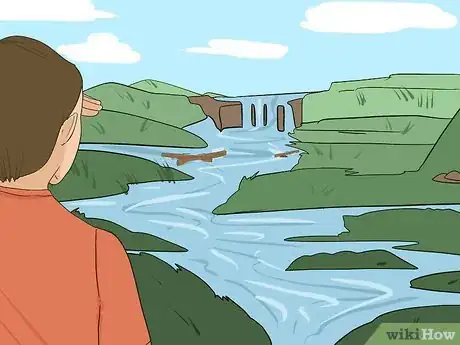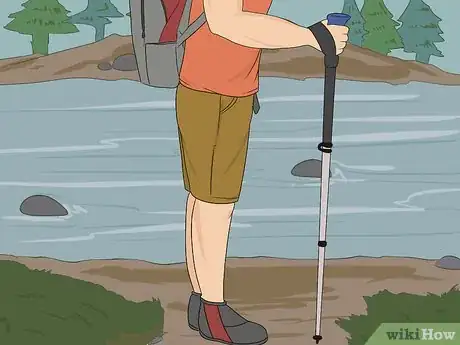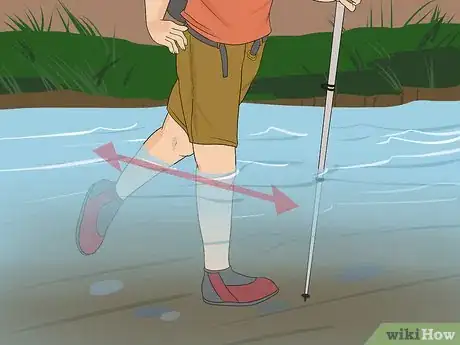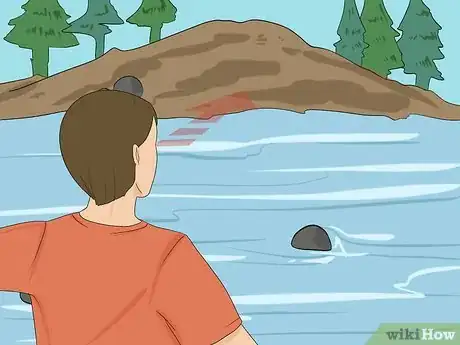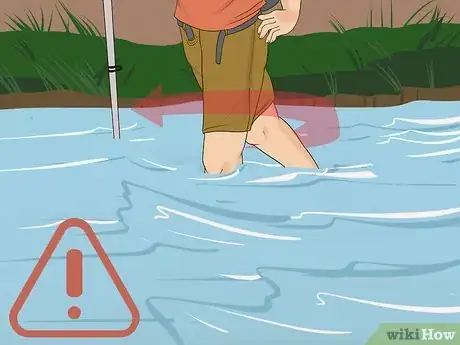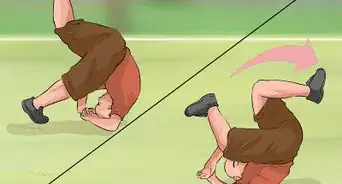This article was co-authored by wikiHow Staff. Our trained team of editors and researchers validate articles for accuracy and comprehensiveness. wikiHow's Content Management Team carefully monitors the work from our editorial staff to ensure that each article is backed by trusted research and meets our high quality standards.
This article has been viewed 42,616 times.
Learn more...
If you're hiking in the great outdoors, you may come across a river that you need to cross. You may think it's simple and easy, but if you don't take the proper precautions, crossing a river can be very dangerous. To cross a river safely, you need to find the best place to make your crossing, prepare yourself and your gear, and head against the current as you cross at a diagonal angle to the other bank.
Steps
Finding a Place to Cross
-
1Choose a straight section of the river to cross. Crossing at a bend in a river can take longer and make it more difficult to cross. If you picture the river as forming the letter “S,” then the safest part to cross would be the middle of the letter “S,” between the bends of the river.[1]
- If you do happen to lose your footing and fall in the water, then the current would be more likely to carry you to the bank of the outside of the bend in the river.
- If you have a map and know your location, look for a straight section of the river to cross.
-
2Check the current before you attempt to cross it. Throw a stick into the river to see how fast the water is moving. The faster the current is, the more shallow the water needs to be in order for you to cross it safely.
- If you can't walk as fast as the stick floats downstream, then the current is too fast for you to cross.
Advertisement -
3Make sure the water is not deeper than your knees. Crossing water that is deeper than your knees is difficult and dangerous because you could get swept downstream in the current. The only time you should cross water deeper than your knees if there is little to no current.[2]
Tip: If you can't see the bottom of the river because the water is muddy or silty, toss a rock into the current. If you hear a hollow sounding “ker-ploop” sound, it means the water is deep.
-
4Look out for debris in the water. If you see a lot of branches and logs floating downstream in the water, it could make crossing the river much more difficult and dangerous. Debris in the water can trip you or cause a serious accident while you're crossing the river.
- If you can see debris floating downstream then that means there is probably even more debris in the water that you can't see.
-
5See if there is a break in the river that will help you cross. Check to see if there is an island or a sandbar in the middle of the river that could provide a resting place to help you cross. A break in the river may make the current on either side of it more manageable to cross.[3]
- Crossing at a point in the river where there a lot of little channels can help make the current more manageable than crossing one wide stretch of river.
- A large tree or log in the middle of the river could also provide a place for you to rest as you cross the river.
-
6Cross glacial rivers in the morning. If you're trying to cross a stream or river that is fed by melting snow and ice, you need to cross the water early in the day, before afternoon melting. The water will be shallower and the current will be slower in the morning.[4]
Making Preparations to Cross
-
1Change into shorts and spare sandals or shoes. Pants can become waterlogged and make it more difficult to cross without getting swept away in the current. You also don't want to have soaked boots after you cross, so change into a spare set of shoes or sandals before you cross.[5]
- You also don't want to walk around in wet clothes because you can get hypothermia. Change into a spare pair of clothes so you can change back once you reach the other side of the river.
- The spare shoes should still fit snugly so they don't come off or trip you up while you're crossing.
Tip: Do not cross a river barefoot. You'll have less traction and grip and you'll expose your feet to sharp objects on the riverbed.
-
2Loosen your backpack and gear before you cross. Unbuckle your hip belt and loosen the straps keeping your gear attached to you. If you fall, you need to be able to remove your gear before it fills up with water and drags you downstream in the current.[6]
- No gear or equipment is worth risking your life over.
-
3Use a trekking pole or a sturdy stick for stability. A trekking pole or a sturdy stick about 5–6 feet (1.5–1.8 m) long can help increase your balance and provide another point of contact with the river bottom to help you cross the river more easily.[7]
Moving Across the River
-
1Keep 2 points of contact with the ground at all times when you cross. For increased support and stability, whenever you cross a river, always keep at least 2 points of contact with the riverbed using your pole or stick and one of your feet. This will make you less likely to trip or get caught in the current.[8]
- Form a tripod with your two feet and your pole or stick.
-
2Move across the river at a slight angle against the flow of water. Slide your feet slowly forward as you walk in a diagonal direction across the river. Walk against the flow of the river and head towards the opposite bank.[9]
- If you're in a group of people, move in a diagonal line across the water and walk against the direction of the current.
- Use your pole or stick to probe in front of you to check for large logs or other debris.
-
3Lock arms and have the strongest person lead the way. The person in the front of the group will break the current and make the crossing easier for the rest of the group, so they need to be the strongest and most capable person in the group.[10]
Tip: If you're in a group of three people, form a tripod or a triangle. Lock arms and have each person face into the center of the tripod.
-
4Keep your eyes focused on the shore rather than the water in front of you. The best way to make sure that you're moving across the river in the direction that you want is to keep your eyes fixed on a spot on the opposite shore. Don't look down at the water in front of you for too long or you could veer off course.[11]
- Looking at rushing or swirling water can also make you dizzy and disoriented.
- You should still keep an eye out for debris, branches, and logs, but try to use your periphery vision so you can focus on the other shore.
-
5Stay calm and don't panic if you fall. Panicking if you trip or fall can cause you to hyperventilate or make irrational decisions. If you do happen to fall while you're crossing the river, remove your backpack or gear if it makes getting back up too difficult. If the current starts to sweep you down the river, flip onto your back and point your feet downstream.[12]
- Wait until you reach calm water or the current slows down to swim to shore.
-
6Turn around if the current is too strong or the water is too deep. If at any point during your crossing you feel unsure about your footing, the current, or the depth of the water, you should turn around and return to shore. You can always try again later or search for a better place to cross the river.[13]
Warnings
- Crossing a river can be extremely dangerous. Avoid having to cross deep water or a fast-moving current.⧼thumbs_response⧽
References
- ↑ https://www.nps.gov/articles/safe-river-crossings.htm
- ↑ https://www.backpacker.com/skills/how-to-ford-a-river
- ↑ https://www.nps.gov/articles/safe-river-crossings.htm
- ↑ https://www.backpacker.com/skills/how-to-ford-a-river
- ↑ https://www.nps.gov/articles/safe-river-crossings.htm
- ↑ https://www.backpacker.com/skills/how-to-ford-a-river
- ↑ https://www.nps.gov/articles/safe-river-crossings.htm
- ↑ https://www.backpacker.com/skills/how-to-ford-a-river
- ↑ https://www.liveabout.com/how-to-safely-cross-a-river-756020



